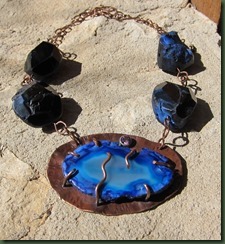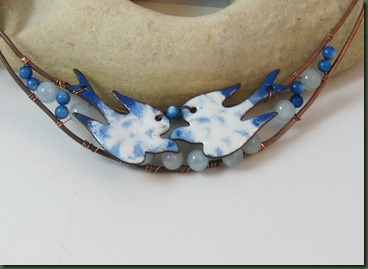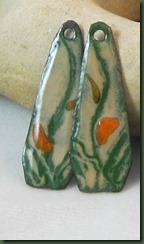The last two jewelry making classes that I’ve taught involved working on various types of prong settings. Although I don’t have any more of these scheduled, I’m still intrigued by the unique possibilities that soldered prongs present for jewelry construction.
I think the blue agate piece below might be called “snakes” except that might not be a very appealing title for a customer. I wanted to add a tube setting to this piece and used a 6mm lab grown amethyst. It seems to help bring out the color in the agate.
There’s always considerable problem solving in jewelry construction even when you’ve made the best of plans. I share my mistakes as a pat on the back for those of you who don’t make them (anyone out there???) as well as encouragement for the rest of us. My mantra seems to be “where there’s a will, there’s a way”. After the entire pendant was complete – soldered, filed, sanded, formed, patinated, etc. – I carefully set the stone and positioned the prongs over it. So far so good. Then I placed the amethyst in the tube bezel and used my new bezel setter to secure it . . . beautiful. But then . . . plop. . . out came the stone. Not to be dismayed, I tried again and again and then . . . I realized that I had soldered the tube bezel onto the back plate upside down! I knew I should start again, remove the agate and go back to the torch station.; but I didn’t. I recently read that a renowned jewelry maker/teacher uses glue in certain situations. THIS was my situation. I got that little E-6000 tube out of the drawer, glued that little stone in the tube bezel and if I hadn’t fessed up, you might never have known.
The second prong setting is a green agate. I cut a piece of 22g copper sheet to create the partial bezel and then used a two-legged prong setting at the top. In essence, the bezel simply keep the stone from sliding out the bottom. The prong provides tension from the top and holds the piece against the back plate. I also used a little bit of that E-6000 on the back of the stone so I would feel better. The bezel is a bit of copper tubing soldered on the front and I embellished the pieces by wiring some small glass beads to the prong. By the way, twice I filed and sanded the back of the piece too closely where the prongs come through and had to re-solder them. Oh well, it gave me good practice!
Did I learn anything? I found that self deprecation when something doesn’t go right doesn’t help me in making jewelry. When a prong failed to solder properly, I just said “oh great, now I get to go back down the stairs to the torch room.” (More exercise and more practice can’t be all bad!) Now, if something doesn’t give me a problem, I’m suspicious. Could attitude be 9/10s of the work ethic?
For my soldering students, keep smiling and torch on.

























